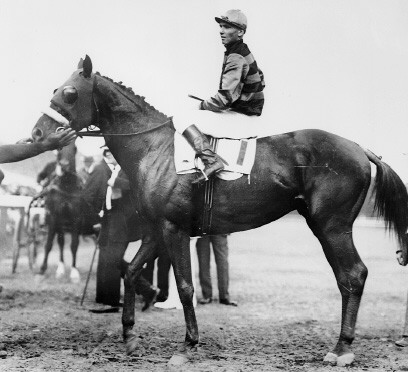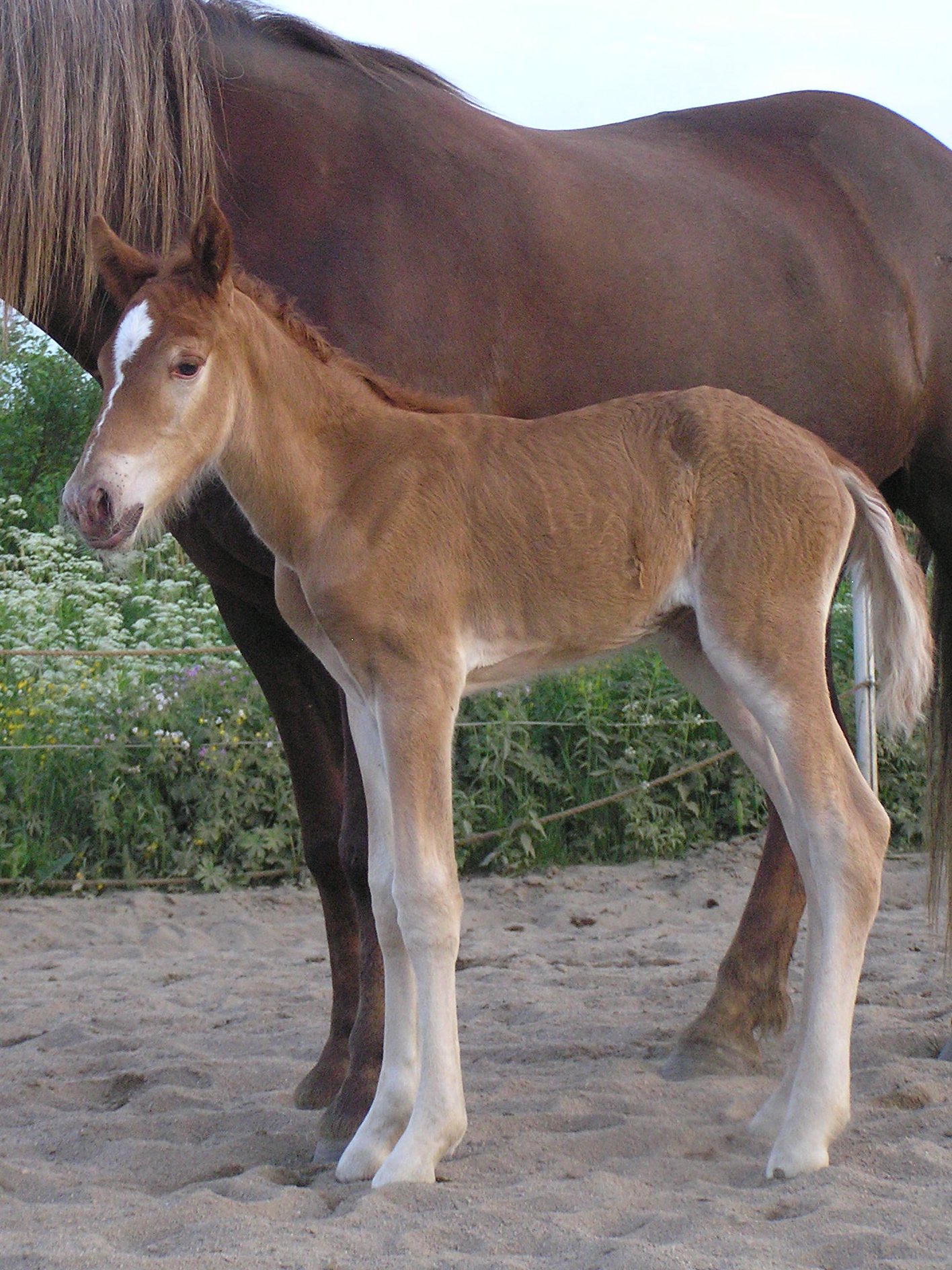|
Empire City Derby
The Empire City Derby was an American Thoroughbred horse race held annually from 1917 through 1933 at Empire City Race Track in Yonkers, New York. A race for three-year-old horses of either sex, the event was contested at a mile and one-eighth at inception until 1920 when it was set at what became known as the "Derby distance" of a mile and one-quarter. With the Brooklyn Derby at Belmont Park having changed its name to the Dwyer Stakes, the Empire City Derby was then the only Derby event in the Northeastern United States. Historical notes First run on July 21, 1917, the race was won by Rickety, a colt trained by future Hall of Fame inductee James G. Rowe Sr. Rickety was owned by Harry Payne Whitney, a leading horseman at the time and member of the prominent Whitney family who in 2018 was honored by the National Museum of Racing and Hall of Fame as one of the Pillars of the Turf. Whitney had won the 1915 Kentucky Derby with his Hall of Fame filly Regret and in addition to his ... [...More Info...] [...Related Items...] OR: [Wikipedia] [Google] [Baidu] |
Empire City Race Track
Yonkers Raceway & Empire City Casino, founded in 1899 as the Empire City Race Track, is a one-half-mile standardbred harness racing dirt track and slots racino located at the intersection of Central Park Avenue and Yonkers Avenue in Yonkers, New York, near the New York City border. It is owned by Vici Properties and operated by MGM Resorts International. History Yonkers Raceway, considered a city landmark, was opened in 1899 by William H. Clark's Empire City Trotting Club. Clark died in 1900 and, with much litigation by his heirs over its proposed sale, the track remained closed for most of the next seven years except for special events. One such event occurred in 1902 when Barney Oldfield set a one-mile (1.6 km) record in an automobile at Empire City Race Track. Driving the Ford '999', he covered the distance in 55.54 seconds. The facility was purchased by New York grocery store magnate James Butler, who reopened it for Thoroughbred horse racing in 1907. Among the notable t ... [...More Info...] [...Related Items...] OR: [Wikipedia] [Google] [Baidu] |
Preakness Stakes
The Preakness Stakes is an American thoroughbred horse race held on Armed Forces Day which is also the third Saturday in May each year at Pimlico Race Course in Baltimore, Maryland. It is a Grade I race run over a distance of 9.5 furlongs () on dirt. Colts and geldings carry ; fillies . It is the second jewel of the Triple Crown, held two weeks after the Kentucky Derby and three weeks before the Belmont Stakes. First run in 1873, the Preakness Stakes was named by a former Maryland governor after the colt who won the first Dinner Party Stakes at Pimlico. The race has been termed "The Run for the Black-Eyed Susans" because a blanket of Rudbeckia hirta, Maryland's state flower is placed across the withers of the winning colt or filly. Attendance at the Preakness Stakes ranks second in North America among equestrian events, surpassed only by the Kentucky Derby. History Two years before the Kentucky Derby was run for the first time, Pimlico introduced its new stakes race for ... [...More Info...] [...Related Items...] OR: [Wikipedia] [Google] [Baidu] |
Bewitch
Bewitch (1945–1959) was a Thoroughbred race horse born in 1945 at Calumet Farm, Kentucky, United States in the same crop in which the stallion Bull Lea produced Citation and Coaltown. Each of them was eventually inaugurated into the Thoroughbred Hall of Fame. Bewitch was the only filly of the three. From her dam, Potheen (purchased by Warren Wright for the small sum of $500), Bewitch inherited the blood of Broomstick, whose sire was the great Ben Brush. On her mother's side also flowed the blood of Peter Pan (sired by Commando) and Hanover (sired by Hindoo). Trained by the Hall of Famer Ben A. Jones, as a two-year-old Bewitch won her first eight starts, six of them consecutive stakes races. In her first effort, she led throughout and won by six lengths. One of these stakes was the Washington Park Futurity, in which she beat Citation, the only defeat he suffered as a two-year-old. Before the end of her first season, Ben Jones turned her training over to his son, Jimm ... [...More Info...] [...Related Items...] OR: [Wikipedia] [Google] [Baidu] |
Alsab
Alsab (1939–1963) was an American Hall of Fame Thoroughbred racehorse. Background Alsab was bred in Kentucky by Thomas Piatt. His sire was Good Goods, and his dam was Winds Chant. Buyers were not interested in him, and Alsab was sold in 1940 for only $700 to Albert Sabath. He was named after his new owner. Racing career As a two-year-old, Alsab won the Washington Park Futurity, Champagne Stakes, and Mayflower Stakes. In his three-year-old season, he was ridden by Basil James. He finished second to Shut Out in the Kentucky Derby and then won the Preakness Stakes. In the third leg of the Triple Crown he finished second to Shut Out in the Belmont Stakes. On September 19, 1942, Alsab defeated the 1941 U.S. Triple Crown Champion Whirlaway in a match race at Narragansett Park in Pawtucket, Rhode Island. Assessment and awards Alsab was voted the 1941 U.S. Champion Two-Year-Old Colt. He also won 1942 U.S. Champion Three-Year-Old Colt honors. In the Blood-Horse magazine ... [...More Info...] [...Related Items...] OR: [Wikipedia] [Google] [Baidu] |
Pot O'Luck
Pot O'Luck (1942) was an American Thoroughbred racehorse bred and raced by the renowned Calumet Farm of Lexington, Kentucky. He was sired by Chance Play, the 1927 retrospective American Horse of the Year and 1935 Leading sire in North America. Out of the mare Potheen, his damsire was Wildair, winner of the 1920 Metropolitan Handicap. 1944 Trained by future U.S. Racing Hall of Fame inductee Ben Jones, racing at age two Pot O'Luck notably won the Champagne Stakes at New York's Belmont Park and the Pimlico Futurity at Baltimore's Pimlico Race Course. 1945 At three, Pot O'Luck won five of twenty-one starts and earned $149,220. He ran second to Hoop Jr. in the 1945 Kentucky Derby but won a number of important races that year including the 11/16 mile Ben Ali Stakes at Keenland Race Course, the 1¼ mile Arlington Classic Stakes, the Lawrence Realization Stakes and the Governor Bowie Handicap, both at 1⅝ miles, as well as the Jockey Club Gold Cup at two miles. 1946 Pot O'Luc ... [...More Info...] [...Related Items...] OR: [Wikipedia] [Google] [Baidu] |
Damsire
Horse breeding is reproduction in horses, and particularly the human-directed process of selective breeding of animals, particularly purebred horses of a given breed. Planned matings can be used to produce specifically desired characteristics in domesticated horses. Furthermore, modern breeding management and technologies can increase the rate of conception, a healthy pregnancy, and successful foaling. Terminology The male parent of a horse, a stallion, is commonly known as the ''sire'' and the female parent, the mare, is called the ''dam''. Both are genetically important, as each parent genes can be existent with a 50% probability in the foal. Contrary to popular misuse, "colt" refers to a young male horse only; "filly" is a young female. Though many horse owners may simply breed a family mare to a local stallion in order to produce a companion animal, most professional breeders use selective breeding to produce individuals of a given phenotype, or breed. Alternatively, a ... [...More Info...] [...Related Items...] OR: [Wikipedia] [Google] [Baidu] |
Metropolitan Handicap
The Metropolitan Handicap, frequently called the "Met Mile", is an American Grade I Thoroughbred horse race held at Belmont Park in Elmont, New York. Open to horses age three and older, it is contested on dirt over a distance of one mile (8 furlongs). Starting in 2014, it is now run on the same day as the Belmont Stakes in early June. The Met Mile is one of the most prestigious American races outside of the Triple Crown and Breeders' Cup. It is known as a "stallion-making race" as the distance of a mile often displays the winner's "brilliance", referring to an exceptional turn of foot. Winners of the race who went on to become notable stallions include Tom Fool (1953), Native Dancer (1954), Buckpasser (1967), Fappiano (1981), Gulch (1987–88), and Ghostzapper (2005). History The Met Mile was first run in 1891 at Morris Park Racetrack. Prior to 1897, it was run at a distance of miles. In 1904, its location was moved to Belmont Park. There it remained except for nine ye ... [...More Info...] [...Related Items...] OR: [Wikipedia] [Google] [Baidu] |
Wildair
Wildair (foaled 1917 in Kentucky) was an American Thoroughbred racehorse bred and raced by Exemplar of Racing Harry Payne Whitney and trained by U.S. Racing Hall of Fame inductee, James Rowe Sr. Wildair's most important race win came in the 1920 Metropolitan Handicap, one of the most prestigious American races outside of the Triple Crown series. Breeding Regally bred, Wildair was sired by Hall of Fame inductee Broomstick who was the son of another Hall of Fame inductee, Ben Brush. Wildair's dam was Verdure by yet another Hall of Fame inductee Peter Pan. [...More Info...] [...Related Items...] OR: [Wikipedia] [Google] [Baidu] |
Walter Vosburgh
Walter may refer to: People * Walter (name), both a surname and a given name * Little Walter, American blues harmonica player Marion Walter Jacobs (1930–1968) * Gunther (wrestler), Austrian professional wrestler and trainer Walter Hahn (born 1987), who previously wrestled as "Walter" * Walter, standard author abbreviation for Thomas Walter (botanist) ( – 1789) Companies * American Chocolate, later called Walter, an American automobile manufactured from 1902 to 1906 * Walter Energy, a metallurgical coal producer for the global steel industry * Walter Aircraft Engines, Czech manufacturer of aero-engines Films and television * ''Walter'' (1982 film), a British television drama film * Walter Vetrivel, a 1993 Tamil crime drama film * ''Walter'' (2014 film), a British television crime drama * ''Walter'' (2015 film), an American comedy-drama film * ''Walter'' (2020 film), an Indian crime drama film * '' W*A*L*T*E*R'', a 1984 pilot for a spin-off of the TV series ''M*A*S*H'' * ' ... [...More Info...] [...Related Items...] OR: [Wikipedia] [Google] [Baidu] |
Racemare
Glossary of North American horse racing: Additional glossaries at: *Glossary of Australian and New Zealand punting *Glossary of equestrian terms This is a basic glossary of equestrian terms that includes both technical terminology and jargon developed over the centuries for horses and other equidae, as well as various horse-related concepts. Where noted, some terms are used only in Americ ... * Parimutuel betting#Parimutuel bet types A B C D E F G H I J L M N O P Q R S T U W References Bibliography * * External linksFrankie Lovato's 365 Days of Ra ... [...More Info...] [...Related Items...] OR: [Wikipedia] [Google] [Baidu] |
Chestnut (coat)
Chestnut is a hair coat color of horses consisting of a reddish-to-brown coat with a mane and tail the same or lighter in color than the coat. Chestnut is characterized by the absolute absence of true black hairs. It is one of the most common horse coat colors, seen in almost every breed of horse. Chestnut is a very common coat color but the wide range of shades can cause confusion. The lightest chestnuts may be mistaken for palominos, while the darkest shades can be so dark they appear black. Chestnuts have dark brown eyes and black skin, and typically are some shade of red or reddish brown. The mane, tail, and legs may be lighter or darker than the body coat, but unlike the bay they are never truly black. Like any other color of horse, chestnuts may have pink skin with white hair where there are white markings, and if such white markings include one or both eyes, the eyes may be blue. Chestnut foals may be born with pinkish skin, which darkens shortly afterwards. Chestnut ... [...More Info...] [...Related Items...] OR: [Wikipedia] [Google] [Baidu] |



.jpg)
